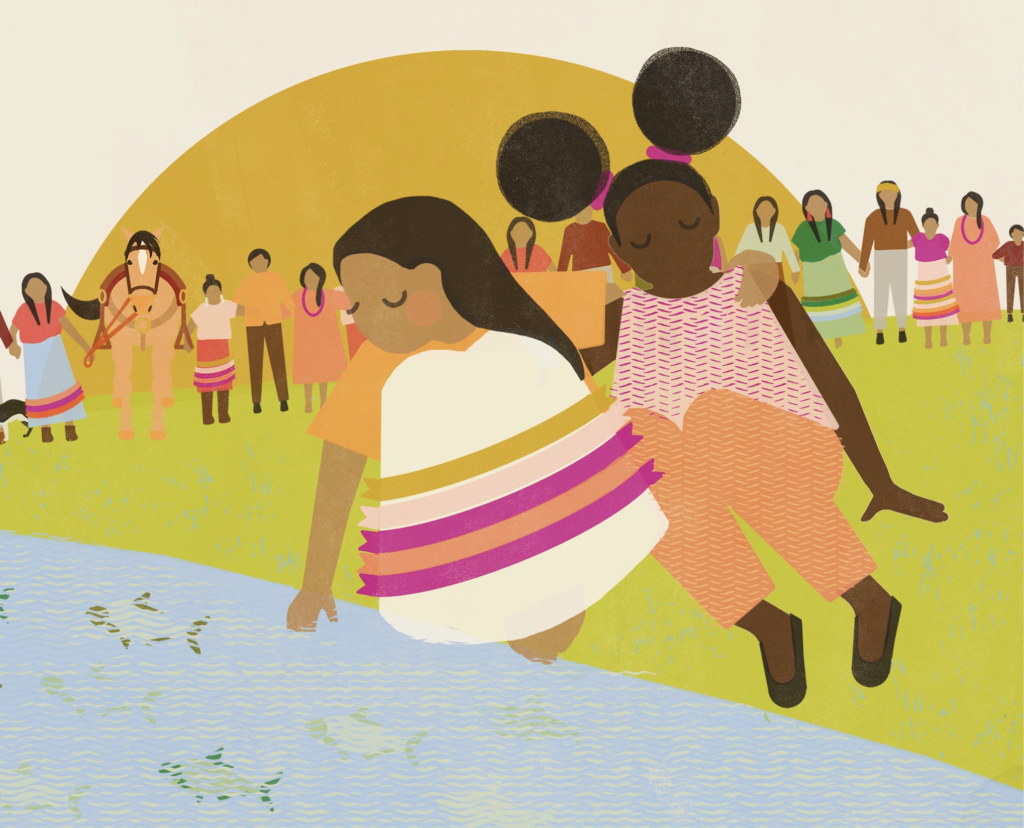Safety also includes our trees and air,
The land we’ve called home, our places of prayer.
I am Dakota, and like my ancestors,
My tribe and I are water protectors.
From profit and power, we stand up to preserve
Our nations, our cultures, and the respect we deserve.
“They killed our river,” an indigenous Amazonian woman in a publicly posted video (original language here) said, describing the destruction to her home and habitat due to decades of illegal deforestation practices in the Amazon rainforest fire. “They killed our source of life.”
The Californian and Australian fires show that climate change is not a regional or country-specific concern. Rather, the widespread devastation of our planet speaks to the fact that environmental justice is an intersectional and transnational feminist issue.
We illustrate this point in our children’s book IntersectionAllies: We Make Room for All. The book illustrates the concept of intersectionality—the idea that social categories like race, class, ability, culture and gender are interconnected—through stories that kids can understand and relate to.
Dakota, one of our characters, voices the need for people to come together to protect our trees and air, our homes and “our places of prayer.” Dakota is depicted participating in the Dakota Access Pipeline protest #NoDAPL, which began in 2016 to stop the construction of an oil pipeline that threatened the Standing Rock Lakota Sioux tribe’s ancient burial grounds and water source.
Much like the Amazonian, Californian and Australian fires, powerful governmental forces implemented policies in Standing Rock that disregarded the needs of communities, both human and non-human, who have a symbiotic relationship with the land. Such policies are crimes not only against humanity, but also crimes against entire ecosystems that are home to millions of organisms, many of which face extinction.

The number of changes being made by everyday people to decrease the use of resources by using products such as reusable straws and tote bags has not gone unnoticed. While these personal solutions are well-meaning, we must meet structural and transnational issues with structural and transnational solutions that account for global and regional power imbalances, as well as different local and cultural relationships with Earth’s natural resources. An individual “pull my family up by the bootstraps” or even “pull our nation up by the bootstraps” approach is much too limited a response.
How can we work together while being mindful of our different vulnerabilities and access to power? How can we honor the perspectives of the communities most affected by environmental issues? How might we include the Earth in our understanding of allyship?
Intersectional feminism can help us answer these questions. In fact, IntersectionAllies demonstrates what answers might look like in a concrete way.
One of our characters—Nia, a child from Flint, Michigan whose water source is also under threat—supports and stands in solidarity with her friend Dakota at the #NoDAPL protest. Their friendship shows intersectional feminism in action, and how children can work together to fight for a need they both share: the right to drink clean water.
We also need to approach communities impacted by fires, earthquakes, hurricanes and other natural and not so natural disasters—eg. Japan’s recovery from the atomic bombing—with allyship. The first step in being an effective ally is asking communities what forms of support they need, mindful that indigenous communities residing near the Amazon rainforest require a different form of advocacy than communities residing in parts of southern and northern California. The power of intersectional allyship lies in its potential to help unite and empower different groups of oppressed people without collapsing or dismissing the meaningful differences between those groups. Through the stories in IntersectionAllies, we seek to uplift anti-racists, de-colonial and inclusive practices to tackle an injustice impacting each and every one of us.
We all depend on the clean air, clean water and oxygen provided by beautiful spaces such as the Amazon rainforest. Fighting for our environment and the collective needs of Earth’s dwellers in ways that best benefits them is putting intersectional feminist social justice in action.
The coronavirus pandemic and the response by federal, state and local authorities is fast-moving. During this time, Ms. is keeping a focus on aspects of the crisis—especially as it impacts women and their families—often not reported by mainstream media. If you found this article helpful, please consider supporting our independent reporting and truth-telling for as little as $5 per month.





